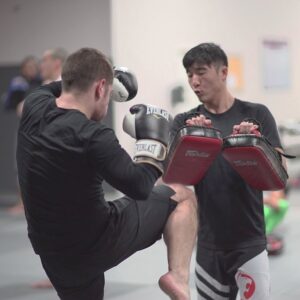
Gym Hygiene at Ground Control Palm Beach
Training at Ground Control Palm Beach means walking into a space where hard work, positivity, and teamwork come first. A clean environment is essential to
When it comes to boxing, mastering your defensive techniques can be just as crucial as your offensive skills. While landing that perfect punch is thrilling, being able to defend yourself effectively opens up more opportunities to strike back with precision and power. A strong defense protects you from incoming blows and helps create openings to counterattack, making your strikes more efficient and devastating.
Our experts from Ground Control Palm Beach break down essential defensive techniques in boxing that will sharpen your skills and ultimately improve your striking ability. Let’s look into the art of defense and how it can transform your offense!
Head movement is one of the most critical aspects of boxing defense. It allows you to avoid punches while staying within range, giving you a perfect window to counter your opponent’s attack. Good head movement keeps you safe and puts you in an advantageous position to strike back.
How to Improve:
Slip the Punch: Practice slipping punches by moving your head just to the left or right of your opponent’s jab. Stay light on your feet and use minimal movement to avoid the strike while staying ready to counter.
Rolling: Rolling under hooks by rotating your upper body and bending your knees is an excellent way to avoid punches. It keeps you close to your opponent, allowing you to fire off a body shot or hook as you come up from the roll.
Perfecting head movement helps you evade punches and keeps you balanced and ready to land your own strikes with greater accuracy.
A strong guard is your main line of defense. It protects your face and body while keeping you poised to counter any attack. Maintaining a proper guard ensures you’re always ready to block incoming punches while keeping your offensive options open.
How to Improve:
High Guard Technique: Keep your hands up, elbows tight, and chin tucked down. This makes it easier to absorb punches on your arms and gloves rather than taking them directly.
Defensive Blocking: Work on making small, efficient movements to block punches. The goal is to keep your defense tight and minimal so you don’t leave any openings for your opponent.
Having a tight guard allows you to absorb punches without taking significant damage, keeping you in the fight and ready to land your powerful combinations.
Good footwork is essential for staying balanced and keeping you out of harm’s way while staying in striking range. Footwork helps you control the distance between you and your opponent, giving you the ability to attack, evade, or counter at will.
How to Improve:
Pivoting: Pivoting is crucial to create angles and avoid incoming punches. Practice pivoting off your lead foot to position yourself at a better angle for counterstrikes.
Lateral Movement: Moving side to side keeps your opponent off balance and guessing. Maintaining good footwork helps you control the pace of the fight, allowing you to set up your punches more effectively.
Mastering footwork helps you dictate where and when exchanges happen, improving your ability to deliver cleaner, more effective strikes.
The parry is an underrated but highly effective defensive technique that allows you to redirect your opponent’s punch while creating an immediate opening for a counterattack. A well-executed parry minimizes the energy you expend on defense while maximizing your chances to land a strike.
How to Improve:
Soft Deflection: Focus on lightly tapping away jabs and straights with quick, controlled motions. The key to a successful parry is timing, so practice regularly to react quickly to incoming punches.
Counter Punching: Practice following up immediately with a counter after parrying a punch. This will keep your opponent on the defensive and increase your striking accuracy and effectiveness.
A good parry allows you to neutralize your opponent’s attack while opening up opportunities to land sharp counterstrikes.
Feints are a versatile tool that can disrupt your opponent’s rhythm, making them hesitant to strike while giving you the chance to land your punches cleanly. Feints create openings for offense and serve as a defensive tool by throwing your opponent off balance.
How to Improve:
Subtle Feints: Keep your feints quick and subtle, using small shoulder, head, or hand movements to trick your opponent into reacting. The less obvious your feint, the more effective it will be.
Mixing Feints with Real Punches: Follow up your feints with accurate punches to catch your opponent off guard. This will keep them second-guessing and give you the chance to land more clean strikes.
When used correctly, feints help control the pace of the fight, keeping your opponent off-balance while giving you a tactical advantage.
A well-rounded boxer knows that defense and offense work together. Perfecting your defensive techniques will keep you safe in the ring and open doors to sharper, more accurate strikes. By mastering these core defensive moves, you’ll find that your ability to land clean, effective punches improves dramatically.
At Ground Control Palm Beach, we emphasize the importance of a well-rounded boxing game. Our expert coaches will help you develop your offensive and defensive skills, ensuring you’re ready for any challenge in the ring. Whether you’re new to boxing or looking to elevate your skills, we offer classes tailored to your needs.
Ready to take your boxing to the next level? Join Ground Control Palm Beach today and become part of a community dedicated to helping you achieve your goals. Sign up for your first class now, and let’s get started!

Training at Ground Control Palm Beach means walking into a space where hard work, positivity, and teamwork come first. A clean environment is essential to

Boxing is one of the most demanding sports in the world, testing endurance, strength, coordination, and mental willpower. It’s not just about how hard you hit; it’s about how long you can stay sharp, explosive, and composed when fatigue sets in.

Known worldwide as the “Art of the Eight Limbs,” Muay Thai blends raw power with razor-sharp precision, impeccable timing, and deep mental strategy. It’s a